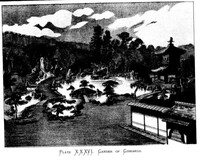TOYAMA-EN GARDEN. The site of the Toyama-En originally covered seventy acres, which was afterwards increased by more than fifty acres, making it the largest landscape garden in Tokio. As first laid out by Mitsusada-Kio, in the year 1665, it had twenty-five remarkable features, besides many other objects of special interest, bearing different fancy appellations. Within recent years the garden has been partly demolished, and the site applied to the purposes of a military school. A central lake, having inlets, rivulets, promontories, and islands, occupied the centre of the design; the surrounding areas abounded in scenery, consisting of groves, moors, hills, marshes, and rice fields, with numerous summer-houses, monuments, and bridges. The palace was situated in the north-east corner of the grounds. The whole arrangement may be seen from the plan (Plate XXXVII), in which many of the principal features are numbered as follows:� 1, The Palace, with inner garden and ornamental enclosures. 2, The Magician's Dell. 3, Garden Tea-room. 4, Hill of Embroidery,�so named from its numerous coloured azaleas and maples. 5, Farmer's House. 6, Water God Shrine. 7, Double-view House. 8, Hermit's Shrine. 9, Jewel-shaped Peak. 10, Gate of Rare Bamboo. 11, Horse Ride, about 150 yards long. 12, Farmer's House, and small Farm. 13, Race Stand. 14, Mirror Well. 15, Stone Image. 16, Seigwanji* Shrine. 17, Carriage Gate. 18, Shrine of Kwannon.* 19, Shrine-attendants Dwelling. 20, Plum-grove. 21, Five-storied Pagoda. 22, Pine Forest. 23, Shrine of Dainichi* 24, Waiting House. 25, Shrine of Hitomaru.** 26, Clear Spring. 27, Dragon-dwelling Valley. 28, Wide Moor. 29, Cherry-forest. 30. Sword-point Peak. 31, Horse-archery Ride. 32, Moor-viewing Arbour. 33, Shrine. 34, Store for Herbs. 35, Shrine of Shaka* 36, Jewel Bridge. 37, Flower-hidden Bridge. 38, Bridge of Cool Breezes. 39, Pine Plantation. 40, Shrine of Monju* 41, The Six Shrines. 42, Royal-entrance Gate. 43, Shrine of Shimmei.** 44, Landscape-viewing Plateau. 45, Shrine of Amida* 46, Willow-side Arbour. 47, Ph�nix-dwelling Valley. 48, Distant View Arbour. 49, Porcelain Kiln. 50, View Stand. 51, Shrine of Benten* 52, Road. 53, Three Huts. 54, River-side Hut. 55, Kamakura*** Road. 56, Mountain Village Tea-house. 57, Bubbling Spring. 58, Kawagoye*** Road. 59, Distant-view House. 60, Shrine of Giogi,* 61, Shrine of Oji-Gongen.** 62, Bamboo Gate. Although the above translations can convey but little idea of the significance of the vernacular names given to the views and objects of this garden, they are sufficient to show what special interest and meaning is attached to every artificial detail. *(Budhist deities.) **(Shinto deities.) ***(Places of interest.)

